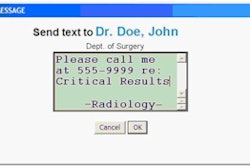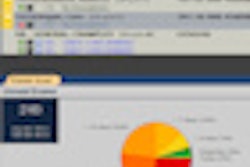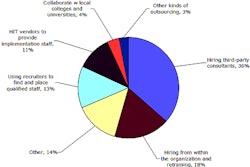In today's world of seemingly omnipresent cell phones and smartphones, along with widespread access to e-mail in most corners of the globe, fast and efficient communication among physicians concerning a patient's test results should be easy. Right?
Unfortunately, conveying critical results and findings from radiology exams in a timely manner to ordering physicians -- and documenting the process -- still generates concern for many radiology professionals. The process is being made easier through critical results reporting software and conversion to electronic records, but it's still far from foolproof.
So what about the reporting of important but noncritical findings? The radiology department at Beth Israel Deaconess Medical Center in Boston uses a two-step process to alert referring physicians about important but nonemergent abnormal imaging results, employing an electronic messaging system administered by two clerical facilitators to simplify this activity for radiologists.
The notification system works well and gets high marks by physicians, based on a study published online September 30 in Radiology.
From the time that PACS first began to be implemented in hospitals, radiologists have commented on the declining number of visits by physicians to radiology departments. Important but not necessarily critical information may not be conveyed as it used to be when direct conversations were more the norm than the exception.
Radiologists at Beth Israel still telephone ordering physicians directly to report findings that require immediate or urgent intervention (level 1) and findings that require treatment within two to three days to prevent substantial morbidity and potential mortality (level 2). Since July 2006, a Web-accessed electronic message system enables radiologists to efficiently notify physicians of level 3 abnormal conditions that are not life threatening but require medical intervention, such as the discovery of a lung nodule.
How it works
Radiologists log onto the system, open an electronic form, and enter the exam identification number. Fields are automatically populated with the patient's demographic data, the name of the ordering physician, and the type of exam performed. The radiologist enters the abnormal findings and recommendations for follow-up exams, and closes the screen.
The message is automatically sent to a message distribution queue, managed by two clerical facilitators during weekday business hours. A facilitator sends the message by e-mail or another method specified by the recipient physician, such as pager, telephone, or fax. When a fax is sent, the facilitator follows up by telephone to verify that it has been received.
The radiologist receives an automated e-mail message that the alert was sent by the facilitator. Both the radiologist and the clinical facilitator receive a time-stamped notification when an alert sent by e-mail has been opened and presumably read by the recipient.
It is the facilitator's job to monitor acknowledgement of the message and to take whatever additional steps are needed if a message is not responded to within 48 hours. At this stage, they start making telephone calls to the ordering physician and/or the primary physician, formally documenting whatever action is taken.
Evaluating effectiveness
To determine the effectiveness of this system, Ronald Eisenberg, MD, and colleagues conducted a study that sampled message delivery over three years of operation. During this time, more than 900,000 diagnostic imaging exams had been performed, and more than 10,000 electronic messages reporting level 3 findings had been sent.
The research team selected every 20th message sent between July 2006 and June 2009, for a total of 500 radiologist-generated alerts. Upon review, 102 of these were disqualified as not meeting level 3 criteria. Of the remaining alerts, 64.6% were sent by e-mail and 34% by telephone notification. An additional seven notifications were made by fax or pager. In three cases, no contact information was available for ordering physicians.
More than 80% of all 500 alerts were received within the radiology department's goal of notification within 48 hours. The day of the week that the alert was generated made a difference: The goal was achieved almost 94% of the time, as long as a message was generated Monday through Thursday afternoon before 3 p.m. Alerts generated late Thursday afternoon through Sunday achieved the goal only 27% of the time.
The overwhelming majority (89.2%) of the alerts originated from radiologists working in the abdominal, musculoskeletal, and thoracic imaging sections. Additional imaging studies were recommended in 65% of the messages.
The researchers also conducted a satisfaction survey with the physicians listed in the 500 sampled messages. Twenty-seven percent of the 438 physicians contacted responded. The majority of respondents were satisfied with the system and preferred to receive an e-mail alert rather than being contacted by phone.
Physicians who responded to the survey offered constructive suggestions, such as adding a rating system that would reflect the importance of the abnormality being reported. Specialists who ordered exams also wanted primary care physicians to receive the alert. Some did not want to receive recommendations from radiologists for additional testing, stating that they then felt obligated to do so to protect themselves from the risk of a malpractice lawsuit.
The evaluation also identified that more than half of the alerts were unclear in terms of clinical importance. The authors are considering establishing specific guidelines that define level 3 abnormalities to help address the issue. They also said they intend to establish evidence-based guidelines that will provide more uniformity with respect to making recommendations for additional imaging studies.
The electronic messaging system will eventually be linked to the hospital's electronic medical record (EMR) system. This will enable all communication of abnormal findings to be recorded automatically and directly added to a patient's electronic records, providing access to all authorized caregivers.
By Cynthia E. Keen
AuntMinnie.com staff writer
October 15, 2010
Related Reading
Some critical alerts for imaging tests are ignored, study shows, September 28, 2009
Automated e-mails reinforce radiology reports for important findings, August 26, 2009
Critical results reporting -- it's cheaper than settling lawsuits, June 5, 2009
New search tool finds the needle in PACS haystack, May 1, 2009
Communicating abnormal findings may not ensure follow-up, November 28, 2007
Copyright © 2010 AuntMinnie.com



















